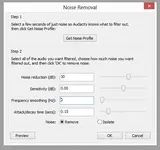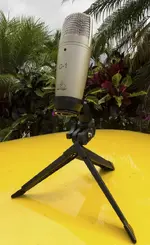W
winkosmosis
New member
Hey folks, I'm trying to learn how to record for a story filming project I'm working on. I did my first test recordings today and I'm trying to figure out noise reduction. I'm using a Tascam DR-40 and Behringer C-1 with Audacity for cleaning up the audio. I'm recording to 96khz 24bit BWF. As a sound card I'm using a Tascam US-144 set to 96khz/24bit output with some cheap Sony ZX-100 on-ear headphones.
I've been messing around with the noise removal effect and I don't really understand the results I'm getting.
Every guide I find says to use a Frequency Smoothing setting of 100-500 depending on the nature of the noise, and that hiss (which I have) requires a higher frequency smoothing setting. As I understand, when Get Noise Profile on a "silent" piece of the recording, the program figures out the frequencies and gets rid of those from the entire track. And hiss is supposed to be a broad range of frequencies so you need a higher tolerance. But I've experimented and I hear zero hiss even with frequency smoothing set to 0. How can that be? Am I just not hearing the noise? Or is Audacity just good enough at removing hiss that I don't need any smoothing?
Also, I tried different dB settings and I can still hear noise at 10dB and 20dB reduction, so I keep it at 30dB. The 0 setting for Sensitivity seems to work best too. If I change it in either direction I get unremoved noise or distortion. So I think I got all the settings dialed in except the smoothing.


I've been messing around with the noise removal effect and I don't really understand the results I'm getting.
Every guide I find says to use a Frequency Smoothing setting of 100-500 depending on the nature of the noise, and that hiss (which I have) requires a higher frequency smoothing setting. As I understand, when Get Noise Profile on a "silent" piece of the recording, the program figures out the frequencies and gets rid of those from the entire track. And hiss is supposed to be a broad range of frequencies so you need a higher tolerance. But I've experimented and I hear zero hiss even with frequency smoothing set to 0. How can that be? Am I just not hearing the noise? Or is Audacity just good enough at removing hiss that I don't need any smoothing?
Also, I tried different dB settings and I can still hear noise at 10dB and 20dB reduction, so I keep it at 30dB. The 0 setting for Sensitivity seems to work best too. If I change it in either direction I get unremoved noise or distortion. So I think I got all the settings dialed in except the smoothing.


